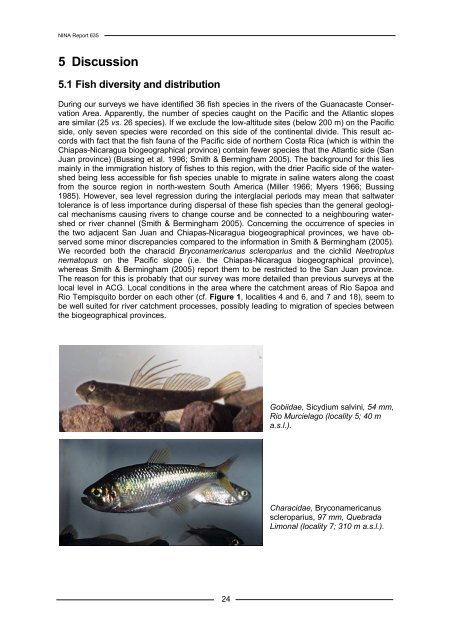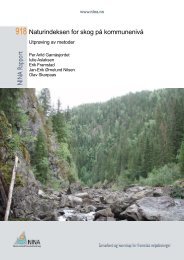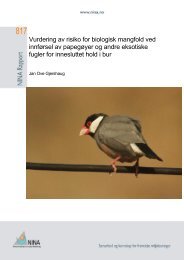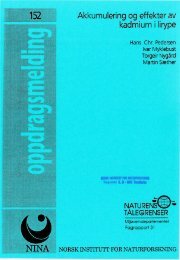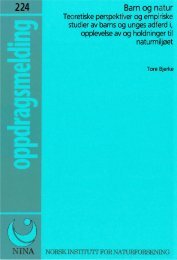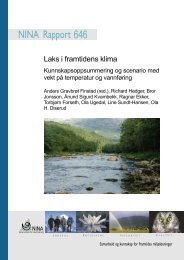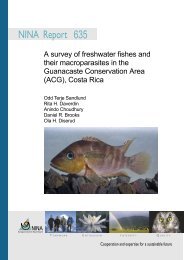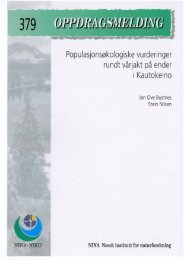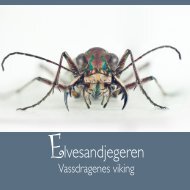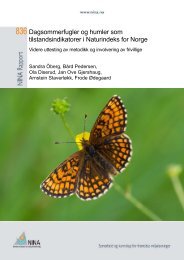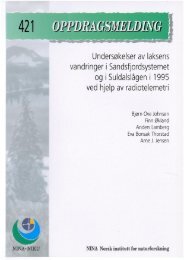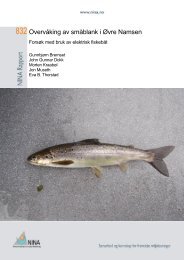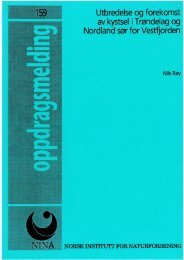A survey of freshwater fishes and their macroparasites in the ... - NINA
A survey of freshwater fishes and their macroparasites in the ... - NINA
A survey of freshwater fishes and their macroparasites in the ... - NINA
You also want an ePaper? Increase the reach of your titles
YUMPU automatically turns print PDFs into web optimized ePapers that Google loves.
<strong>NINA</strong> Report 635<br />
5 Discussion<br />
5.1 Fish diversity <strong>and</strong> distribution<br />
Dur<strong>in</strong>g our <strong>survey</strong>s we have identified 36 fish species <strong>in</strong> <strong>the</strong> rivers <strong>of</strong> <strong>the</strong> Guanacaste Conservation<br />
Area. Apparently, <strong>the</strong> number <strong>of</strong> species caught on <strong>the</strong> Pacific <strong>and</strong> <strong>the</strong> Atlantic slopes<br />
are similar (25 vs. 26 species). If we exclude <strong>the</strong> low-altitude sites (below 200 m) on <strong>the</strong> Pacific<br />
side, only seven species were recorded on this side <strong>of</strong> <strong>the</strong> cont<strong>in</strong>ental divide. This result accords<br />
with fact that <strong>the</strong> fish fauna <strong>of</strong> <strong>the</strong> Pacific side <strong>of</strong> nor<strong>the</strong>rn Costa Rica (which is with<strong>in</strong> <strong>the</strong><br />
Chiapas-Nicaragua biogeographical prov<strong>in</strong>ce) conta<strong>in</strong> fewer species that <strong>the</strong> Atlantic side (San<br />
Juan prov<strong>in</strong>ce) (Buss<strong>in</strong>g et al. 1996; Smith & Berm<strong>in</strong>gham 2005). The background for this lies<br />
ma<strong>in</strong>ly <strong>in</strong> <strong>the</strong> immigration history <strong>of</strong> <strong>fishes</strong> to this region, with <strong>the</strong> drier Pacific side <strong>of</strong> <strong>the</strong> watershed<br />
be<strong>in</strong>g less accessible for fish species unable to migrate <strong>in</strong> sal<strong>in</strong>e waters along <strong>the</strong> coast<br />
from <strong>the</strong> source region <strong>in</strong> north-western South America (Miller 1966; Myers 1966; Buss<strong>in</strong>g<br />
1985). However, sea level regression dur<strong>in</strong>g <strong>the</strong> <strong>in</strong>terglacial periods may mean that saltwater<br />
tolerance is <strong>of</strong> less importance dur<strong>in</strong>g dispersal <strong>of</strong> <strong>the</strong>se fish species than <strong>the</strong> general geological<br />
mechanisms caus<strong>in</strong>g rivers to change course <strong>and</strong> be connected to a neighbour<strong>in</strong>g watershed<br />
or river channel (Smith & Berm<strong>in</strong>gham 2005). Concern<strong>in</strong>g <strong>the</strong> occurrence <strong>of</strong> species <strong>in</strong><br />
<strong>the</strong> two adjacent San Juan <strong>and</strong> Chiapas-Nicaragua biogeographical prov<strong>in</strong>ces, we have observed<br />
some m<strong>in</strong>or discrepancies compared to <strong>the</strong> <strong>in</strong>formation <strong>in</strong> Smith & Berm<strong>in</strong>gham (2005).<br />
We recorded both <strong>the</strong> characid Bryconamericanus scleroparius <strong>and</strong> <strong>the</strong> cichlid Neetroplus<br />
nematopus on <strong>the</strong> Pacific slope (i.e. <strong>the</strong> Chiapas-Nicaragua biogeographical prov<strong>in</strong>ce),<br />
whereas Smith & Berm<strong>in</strong>gham (2005) report <strong>the</strong>m to be restricted to <strong>the</strong> San Juan prov<strong>in</strong>ce.<br />
The reason for this is probably that our <strong>survey</strong> was more detailed than previous <strong>survey</strong>s at <strong>the</strong><br />
local level <strong>in</strong> ACG. Local conditions <strong>in</strong> <strong>the</strong> area where <strong>the</strong> catchment areas <strong>of</strong> Rio Sapoa <strong>and</strong><br />
Rio Tempisquito border on each o<strong>the</strong>r (cf. Figure 1, localities 4 <strong>and</strong> 6, <strong>and</strong> 7 <strong>and</strong> 18), seem to<br />
be well suited for river catchment processes, possibly lead<strong>in</strong>g to migration <strong>of</strong> species between<br />
<strong>the</strong> biogeographical prov<strong>in</strong>ces.<br />
24<br />
Gobiidae, Sicydium salv<strong>in</strong>i, 54 mm,<br />
Rio Murcielago (locality 5; 40 m<br />
a.s.l.).<br />
Characidae, Bryconamericanus<br />
scleroparius, 97 mm, Quebrada<br />
Limonal (locality 7; 310 m a.s.l.).


